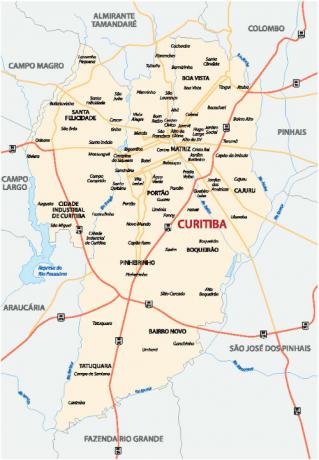Curitiba is a Brazilian city located in the state of Paraná, in the southern region of the country. It houses the seat of the state government, thus performing the function of capital. it is about the most populous city in Paraná, with just over 1.94 million inhabitants. It also represents the fifth largest municipal economy in Brazil, which makes it the main economic center in Paraná and one of the most important in the south of the country.
Read too: What are the capitals of Brazilian states?
Summary about Curitiba
Curitiba is a Brazilian municipality belonging to the state of Paraná. It has played the role of state capital since 1854. Its foundation took place, however, on March 29, 1693.
The city has a subtropical climate and an undulating relief. It is located on a plateau region at more than 900 meters above sea level. Curitiba is part of the Atlantic Forest biome.
It is the eighth most populous capital in Brazil and the largest city in Paraná, with 1,948,626 inhabitants. Curitiba is also densely populated, with today 4,027.04 inhab./km².
It is divided into neighborhoods and regions, the most extensive of which is the Industrial City of Curitiba (CIC). Some of the most important companies installed in Curitiba are located in this region.
The city has the fifth largest municipal GDP in Brazil, with a value of R$87.15 billion. The tertiary sector is the most representative in the Curitiba economy.
It stands out for its urban transport system.
It has numerous tourist attractions, such as the Botanical Garden, the Wire Opera House, museums, memorials, parks and forests.
General data for Curitiba
Gentile: Curitibano
-
Location
Parents: Brazil
Federative unit: Paraná
Intermediate region[1]: Curitiba
Immediate region[1]: Curitiba
-
Metropolitan region: Metropolitan Region of Curitiba
Formed by the following municipalities: Curitiba, Adrianópolis, Agudos do Sul, Almirante Tamandaré, Araucaria, Balsa Nova, Bocaiúva do Sul, Campina Grande do Sul, Campo do Tenente, Campo Largo, Campo Magro, Cerro Azul, Colombo, Contenda, Doutor Ulysses, Fazenda Rio Grande, Itaperuçu, Lapa, Mandirituba, Piên, Pinhais, Piraquara, Quatro Barras, Quitandinha, Rio Branco do Sul, Rio Negro, São José dos Pinhais, Tijuca do Sul and Tunas do Paraná.
Bordering municipalities: Admiral Tamandaré, Colombo, Pinhais, São José dos Pinhais, Fazenda Rio Grande, Araucaria, Campo Largo, Campo Magro.
-
geography
Total area: 434.892 km² (IBGE, 2020)
Total population: 1,948,626 inhabitants (IBGE, 2020)
Density: 4,027.04 inhab./km² (IBGE, 2020)
Climate: Subtropical
Altitude: 945 m
Time zone: GMT -3
-
Historic
Foundation: March 29, 1693
Curitiba geography
Curitiba is a Brazilian city located in South region from Brazil. It belongs to the state of Paraná, playing the role of state capital as it houses the seat of government and its main administrative functions. The municipality has an area of 434,892 km² and is located in the eastern portion of the Paraná territory, approximately 100 km from the coast.
Its territory borders six other municipalities in Paraná, namely:
Admiral Tamandaré, to the north;
Columbus, to the northeast;
Pinhais and São José dos Pinhais, to the east;
Fazenda Rio Grande, to the south;
Araucaria, to the southwest;
Campo Largo and Campo Magro, to the west.
As a metropolis, Curitiba is the center of the Metropolitan Region of Curitiba, formed by a total of 29 municipalities.

Curitiba climate
Being located below the Tropic of Capricorn, Curitiba It has climate predominantly subtropical. This climate type is marked by the distinction of the four seasons, with mild, rainy summers and drier winters. In the capital of Paraná, temperatures vary from 21°C, on average, in summer and 13°C in winter, and there may be variations. The annual volume of rain is approximately 1500 mm.
Curitiba relief
The capital of Paraná is located in a plateau region which is called the plateau of Curitiba. Its urban relief is marked by the presence of wavy features, whose altitudes range from 900 m to 1000 m above sea level.
See too: What are the endogenous agents of relief transformation?
Curitiba Vegetation
The vegetation cover of the city of Curitiba belongs to the biome Atlantic forest.
Much of the region's original vegetation, formed by mixed rainforest, can be found in the so-called private natural heritage reserves (RPPN), which constitute private conservation units. By the end of 2020, the municipality had 34 of these reserves. In addition to these, other areas destined for the same purpose are found in Curitiba, among parks, forests and the Botanical Garden itself.
Among the tree species present in Curitiba's urban landscape, the Araucaria and Yellow Ipes stand out.
Curitiba Hydrography
Curitiba's drainage network is divided into six watersheds, which are the river basins:
atuba
barigui
Bethlehem
Iguazu
Passaúna
Ribeirão dos Padilhas
Some of the watercourses that give their name to the basins serve as the border line between the capital of Paraná and its neighboring municipalities, such as the Passaúna, Atuba and Iguaçu rivers. In addition to them, several streams, streams and lakes make up the municipal network.
Curitiba Map
Location of Curitiba in the state of Paraná, in southern Brazil:

The image below shows the division of the city of Curitiba by regional and its neighboring municipalities.

Curitiba Demographics
Curitiba is the most populous urban center in the state of Paraná and the octave capital with the largest number of inhabitants in Brazil. According to the data of the IBGE for 2020, the municipality has a population of 1,948,626 people. This value is equivalent to 16.9% of all residents of Paraná. In addition, Curitiba concentrates approximately 54% of the population that lives in its metropolitan region, which was 3.22 million people, according to the latest IBGE Census.
The city has a high population concentration. In 2010, the demographic density of Curitiba was 4027.04 inhab./km², thus representing the most populous and also the most populated municipality in Paraná. In Brazil, it ranks 22nd in terms of population distribution. Taking into account the household location, the IBGE survey shows that all Curitibans live in their urban area.
Most of the population of Curitiba declares itself white, with a share of 78.88%. Browns represent 16.79%, while blacks are 2.85%. Curitibanos who declare themselves as yellow account for a share of 1.32%, and indigenous people, only 0.15%.
With regard to social indicators, Curitiba is in 10th place among the highest HDI in Brazil. The value is 0.823, considered too high. It is the city with the biggest HDI of the state of Paraná.
Check out our podcast: What do I need to know about demographic theories?
Curitiba geographic division
The capital of Paraná is currently formed by a 75 neighborhood sets. These neighborhoods, in turn, are arranged in regional calls, which constitute units created aiming to integrate and centralize the activities linked to the management of each of these areas of the city. Curitiba has 10 regional, that are:
New Neighborhood
Good view
big mouth
cashew nuts
CIC
Farm/Gate
Headquarters
pine tree
holy happiness
armadillo
Curitiba Economy
Curitiba is one of the richest cities in Brazil. Your Gross Domestic Product (GDP) is R$87.15 billion, the largest among the municipalities of Paraná and the fifth most expressive on a national scale. Excluding administrative and public activities, the tertiary sector, which corresponds to commerce and services, accounts for almost 70% of Curitiba's GDP. In this area, commercial activities and those linked to the tourist sector stand out.
However O secondary sector account for a share of 17.68% of the GDP of Curitiba, the industry plays an important economic role, both in the municipality and in its region metropolitan area, which concentrate some of the largest national and international industries of various productive branches.
the regional Curitiba Industrial Center (CIC) It houses the main plants installed in the city, and consists of the largest regional extension of the municipality. Some of the companies found in Curitiba operate in the civil construction, chemical and petrochemical, pharmaceutical, steel, furniture and other sectors.
The participation of the primary sector in the municipal economy it is only 0.02%, as shown by IBGE data for 2018, one of the lowest in Paraná. Most of the land was occupied by temporary crops, including beans, potatoes, cassava, corn and soybeans. Animal husbandry, in turn, is led by cattle raising.
Curitiba Government
The city of Curitiba has a representative democratic type of government. The municipal governors are elected by the population of Curitiba, every four years, to hold a term of equivalent time. É O Mayor the maximum authority of the FOROder ANDmunicipal executive. The Legislative Power of the municipality is in charge of the 38 councilors, which make up its City Council.
Curitiba plays the role of capital of the state of Paraná. This means that the seat of the state government is in the city, which is located in the Iguaçu Palace, located in the Civic Center of the city. There, the main political-administrative functions of the state are concentrated.
Curitiba Infrastructure
The city of Curitiba has all its homes in an urbanized area. According to IBGE, 96.3% of these units have access to adequate sanitary sewage. Approximately 76% are located on tree-lined roads, while homes on adequate public roads reach 59%. The municipal water supply network reaches almost all homes in Curitiba (99.1%), and the same occurs with the electricity system, which serves 99.6% of households.
The capital of Paraná stands out for its Integrated Public Transport Network (RIT), which promotes the interconnection between different bus stations through the integration terminals, allowing passengers to pay a single fare and transit through different lines. In certain areas, buses travel through exclusive lanes for this type of transport. The city also has a Tourism Line, which works exclusively for travel between the main tourist spots in Curitiba.

Curitiba Culture
Curitiba has a rich cultural life, which expresses itself through its cinemas, theaters, libraries, museums, historical sites, tourist attractions and cultural centers in the city. The calendar of celebrations and festivities is made up of music and theater festivals, among which the Curitiba Theater Festival stands out, considered the largest in Latin America, for cinema and others, such as the Paraná Ethnic Festival and the international and comic book biennials.
Many of the traditional cultural manifestations of the capital of Paraná and the south of the country can be seen in the craft and plastic arts fairs that occur around the city.
Located in the city or Holocaust Museum, which brings together a collection of items and elements that keep alive the memory of those who lost their lives in concentration camps, in addition to giving a voice to survivors of the perpetual genociderloved by the nazis. Other museums make up the cultural scene in Curitiba, as well as memorials dedicated to the cultures of Ukrainian, Japanese, Arab and Polish immigrants.
Among the places with wide visitation are the Botanical Garden, the Wire Opera House, the Panoramic Tower, the Municipal Market and the historic area of the city.
Check out our podcast: material and immaterial culture
History of Curitiba
Curitiba was founded on March 29, 1693, under the name of Vila de Nossa Senhora da Luz dos Pinhais. The first centuries of occupation were based on well-established rules for building homes and in harmony with natural spaces. Its economy was still small and based mainly on subsistence agriculture and gold activities. Curitiba's economic development takes place.me with the tropeirismo, from the first half of the 19th century, marked by the greatest flow of commerce in the city and its population expansion.
The end of the 19th century was characterized by an intense migratory current who arrived in the city from European and Asian countries. at the time, Curitiba's economy prospered based on yerba mate and nothe logging. Taking into account the status of the city, in 1854, with the establishment of the state of Paraná, Curitiba officially became its capital. Over time, the city became the main urban center in Paraná and one of the most populous in Brazil, also standing out in economic terms.
Image credits
[1] Marcio Jose Bastos Silva / Shutterstock
By Paloma Guitarrara
geography teacher

